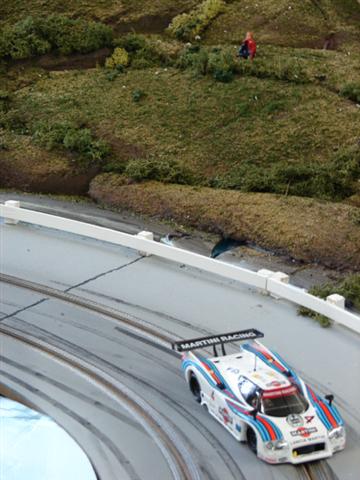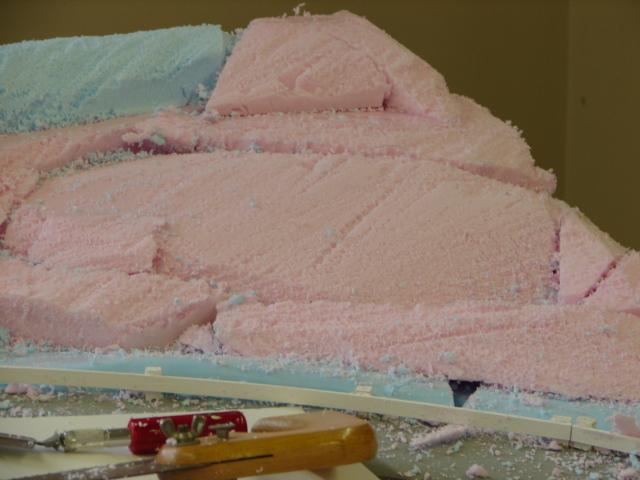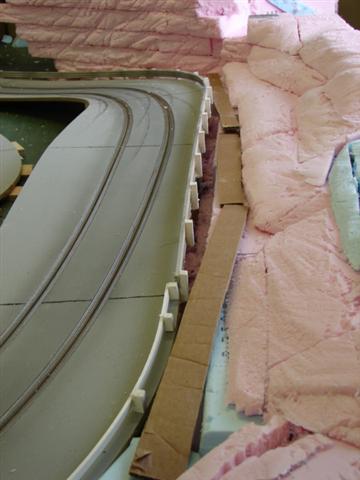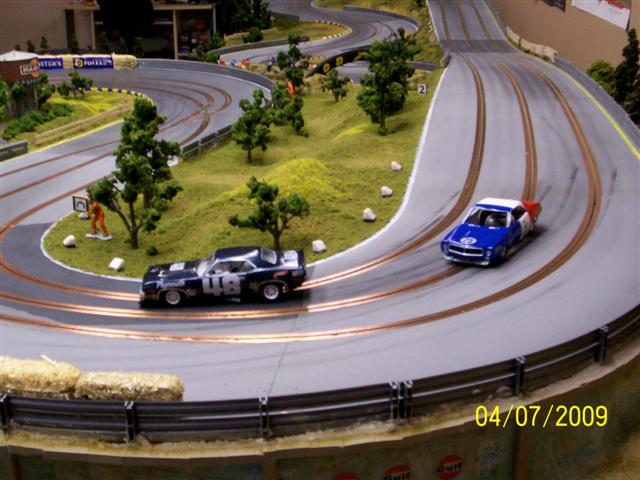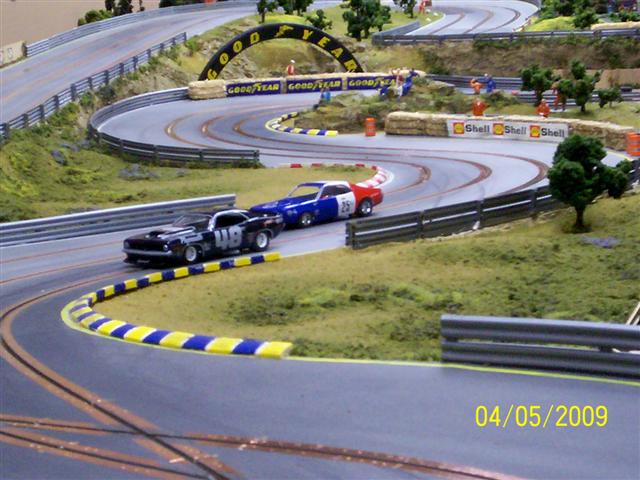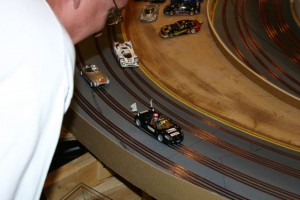Archive
Scale Guardrails on Larry’s San Marino Road circuit
Some track builders have been asking about the guardrails on the San Marino raod course. Dave used the same method of building a stout yet realistic guardrail when he had to create a robust 1/32 scale rail for the top of his high banked Monza turn on his own scale track. See Legends International Raceway in the “Our Tracks” page and refer to pictures of his Monza turn for more examples. He replicated that effort on Larry’s track below.

This steel Aramco guardrail is actually a silver painted length of 3/4" fluted wood molding available at most lumber yard and building centers.
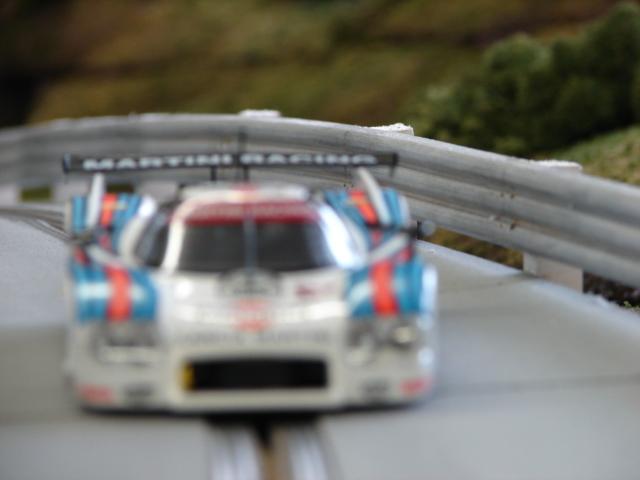
In this close up you can see the detail that Dave added with a simple lead pencil to imitate fastners at each 3/8" X 3/8" post. The posts are all set 4 1/2" apart with a verticle line representing individual rails 12 feet long. Also note the shading with graphite to weather the guard rail and accentuate the fluting.
Car Collision Vs Copper Collision Diagrams
Building on my last post about AC2Car Lane Spacing and Typical Slot Car Spacing and the use of graphic programs such as Adobe Illustrator, here are some visuals regarding what I like to call Car Collision Diagrams and Copper Collision Diagrams. If you recall with AI (Adobe Illustrator) you can draw a singular line and apply visual stroke widths to it. This can enable you to quickly see good and bad areas in your digital track file prep. With a stroke width applied to a line of 180 points (Representing the width of a car) you can create virtual slots and see how cars will mingle with one another. Good and bad can come of this. The most obvious is when you have typical slot car spacing you never want these car lines to run together. With AC2Car its a bit different with the ability to pass. I suggest for a better understanding of the principle slot layout for AC2Car visit our track building page.
Now likewise and more important to AC2Car is taking those same AI lines and applying the stroke value for copper width (Slot and two pieces of copper is a 46 point width) to see where you might have copper from one lane touching an adjacent lane. This is paramount with AC2Car’s tight lane spacing. By going back and forth between car collision stroke width and copper collision stroke width you can succesfully plan your track virtually before routing.
Here is the same section of track, this first image is Correct with NO problem areas with car or copper collisions:

Now this Second Image you can see in the Car Collsion Diagram where Lane 2A is going to hit Lane 1B. Also in the Copper Collision Diagram you can see where lane 2A and 1A Copper would touch one another, ohh ouch shocker!
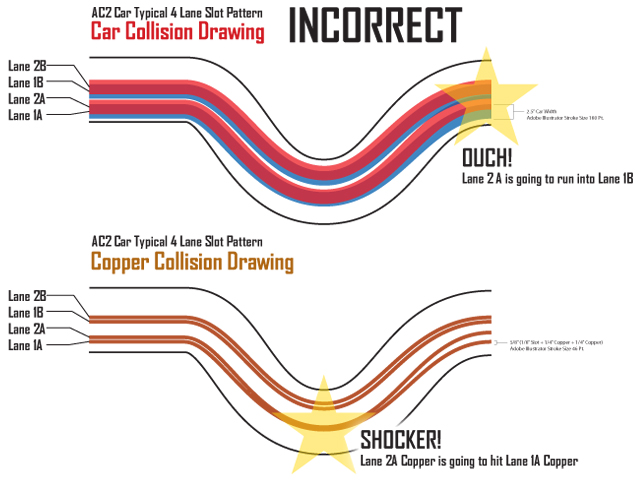
And there you have it! For Standard AC2Car Spacing, these simple diagrams can help you design your track and once you’re finished you can use the very same files for routing. For the daring you might try squeezes in areas where no cars can pass, or wide open even spaced areas where all lanes can pass integrated into your track. Careful though these types will require more experienced respectable drivers to avoid car on car crashes (From experience on my WLF1 Ring)
Scale Racing Scenery- Larry’s Track East side
Track Builders,
Dave sent us progress pictures of his work on the East side of Larry’s track. I thought this would be a good way to illustrate how Dave uses scraps of foam insulating board as the foundation for scenic burms and hillsides adjacent to the track. Yes, it’s the same technique he uses for rock outcrippings but his final colors, and the texture he glues down on to the foam transforms it into a lusher rolling landscape.
As with all model scenic raceways, the final scenery must be coated with drops of a mixture of 50% water, 50% white glue mixed with a drop of dishwashing soap to help the mixture flow out. Large areas can have this mixture sprayed onto it. This coat of clear setting glue is allowed to dry overnight, then repeated two or three times to achieve the surface hardness necessary. 
This hard scape technique keeps car crash impacts from breaking scenery or scraping scenic material onto the race track.
Trans-Am on Rick’s Vintage Mid Ohio
Rick sent us these great photos of his AC2Car powered track. They highlight some of his latest scenery up dates.
The cool Trans-Am cars in the foreground are resin body scratch built cars (RMS resins)with decals from(Slotcars4u) .
Rick writes, “Big thanks go to Dave Reinecke (RMS resins) and Tim Millward (Slotcars4u) for the super great service”
Note how the roadway on VMO Raceway “undulates”. (I love that word)
A layout routed of MDF gives a track builder the ability to create exciting changes in elevation.
Though Rick’s track is 1/2″ thick, now we are finding that 3/8″ thick MDF makes adding rises, dips and banking even easier.
Great to race on, and even better for realistic track scenery!
Understanding AC2Car Lane Spacing
One of the main reasons I was turned on to AC2Car tracks was the lane spacing. This provides two wonderful aspects: Narrower road widths and two unique drive lines around the track for each driver. Narrow road widths mean more track in your space. Two lines around for each driver means twice the fun! Continuing into the future I’ll try and provide some insight into AC2Car track design begining here with this visual: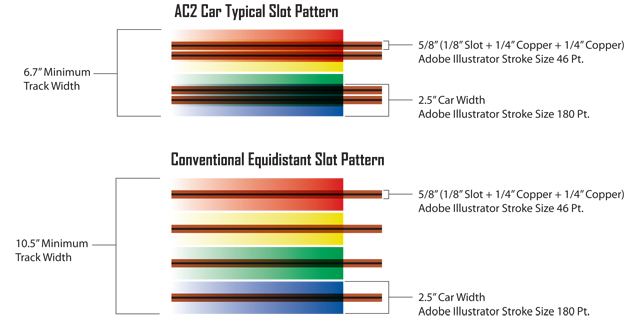
This is based on a four lane track. You can instantly see the road width advantage of AC2Car Spacing. I use Adobe Illustrator for track design, if you are familiar with it or other graphic vector programs such as Corel Draw you can do it too. I look at a track design in two distinct ways for AC2Car. One is the slot and copper spacing which I call Copper Collision Drawings. Number two is car spacing which I call Car Collision Drawings. In Vector based programs you can draw singular lines and apply stroke widths to them. Stroke widths are merely a visual width of a line, the program and others still see it as a singular no width line which is useful down the road. You can draw line segments with a pen tool in the software and apply the appropriate stroke width to it to see how things are running together. Obviously you don’t want the copper from one lane touching another and depending on the type of track you don’t want cars running into each other. In AC2 Car’s case its a little of both. You can find explanations of that in the Track Building section. In the graphic above I’ve noted Adobe Illustrator stroke values for the copper and slot width as well as a 1/32 scale car width. By combining the two visuals you can create a succesful plan before routing a single piece of wood.
Is widening the track at a straightaway a good idea?
Frank Asks ” Is widening the track at a straightaway a good idea. I noticed that on your track?”
Jimmy’s Answer:
On my Northline raceway, (designed 20 years ago and the original test mule for AC2Car racing) I gradually spread out the slots to allow more passing as the lap progressed. This widened the layout and used up more space, but allowed a bit more passing. Today I recommend sticking with the AC2Car pattern all the way around the track until the cars come back to the lane changing area where the drivers can switch sides of the road.
If you build a new track keep this point in mind. When initially designing their layouts, guys around the world insist on spreading the slots out for more passing room, but fail to realize that after spreading them out, if you bring the slots back to the original AC2Car pattern it causes trouble.
Each time you bring the slots back together you create a funnel that causes crashes. The only place that all the slots should come together is once per lap , just before the lane changing area at a chicane or tight turn. After the drivers get by the switches the slots part into the RH and LH sides of the road. After that, cars running on the same side of the roadway should not be given the room to pass each other by spreading their slots out, unless you intend on holding that wider pattern for the rest of the lap.
On paper, it looks like you are doing the drivers a favor by giving them room to pass cars on the same side of the road, but it causes crashes when the slots come back together and two cars try to occupy the same space.
As you review the photos of my slot pattern, please remember that the odd middle most slot was cut down the middle of my track with no lane changing capability. Designed for my 5 year old,(now 27) it’s used today for beginners and kids. I wouldn’t recommend copying that idea.
Do I have to use a model railway transformer or will any AC transformer work?
No need to specifically use a train transformer, but we just thought it would be easiest to point guys to those. They have good adjustable voltage range and are easy to wire up and available on eBay.com for not too much money.
How do the marshals get inside the track to put the cars back on the Legends Track?
How do the marshals get inside the track to put the cars back on the Legends Track?
Unlike my Northline Raceway, right from the start we designed Dave’s Legends track to be set up to use 2 foot gripper tools. I began using them for the kids to use when marshaling at my track. Grippers are 24 inch long wands with hand controlled clamping abilities used to reach high shelves or install light bulbs in high places. They are sold under different names at hardware stores. They have rubber claws that hold a race car firmly, yet gently. We did design in an access point in the middle of Dave’s track, but it will only be used for construction purposes and may be covered with a lift off removable scenery panel. There were about 5 places on Legends that I thought would only be accessible using a Gripper, but as it turns out three of those marshaling points can be reached by most adults. By extending a marshal’s reach another 2 feet, we were able to design in far more track to race on. If had to design my track over again, I’d worry less about accessibility and add more linear feet of track into the space. The AC2Car form of racing is more disciplined than magnetic “rhythm” racing. Cars on AC2Car tracks do need marshaling, but the models are not flashing around in a blur, flying off all the time. However I have to admit, that when the kids race here we have more than out share of fetching downed cars. But, the Gripper type tools work well.
